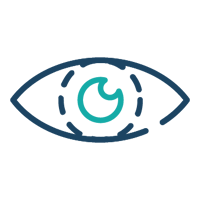Binocular vision refers to the ability of the eyes to work together. The term binocular vision dysfunction describes a misalignment between the lines of sight of each eye. Those with good binocular vision have the ability to point both eyes at the same point in space and to combine the images that their right eye sees with what their left eye sees into a single image.
However, with someone who has binocular vision dysfunction, the eyes are misaligned, and the brain is unable to put together an accurate picture of the combined image from both eyes.
There are many different causes and symptoms of BVD.
What are the Symptoms of Binocular Vision Dysfunction?
Binocular vision dysfunction has a lot of different symptoms that include:
- Fatigue
- Headaches
- Vertigo
- Dizziness
- Balance problems
- Nasuea
- Brain fog
- Double vision
- Problems with 3d vision or depth perception.
- Problems with eye alignment
When the eyes don't work together well, the brain will also often adapt by suppressing or filtering out some of the vision in one eye. While this keeps you from seeing double, it can also reduce your ability to perceive depth or 3D vision.
Many people with binocular vision problems have trouble aligning their eyes. The misalignment may be from the eyes crossing inward or drifting apart. It can also be because one eye is aiming higher or lower than the other.
What are the Causes of Binocular Vision Dysfunction?
Binocular vision dysfunction can be caused by a wide range of factors. Many people believe it's due to weak eye muscles, but this is almost never the case.
The causes of binocular vision dysfunction include:
- Neurodevelopmental delays
- Poor muscle tone
- Brain injuries from car accidents or concussions
- Resulting from neurodegenerative conditions, such as Parkinson's disease.
- In rare cases, it can be caused by brain tumors
What is Vertical Heterophoria?
Vertical heteropopia is a condition in which the line of sight is higher from one eye than it is from the other. The misalignment (either vertical or horizontal) makes it difficult for the brain to combine the two images taken in by our eyes. This creates difficulties with 3D vision, tracking and much more.
How is Binocular Vision Dysfunction Treated?
The treatment options differ depending on the severity of the case.
Treatment options may include one or more of the following:
- Vision therapy, which is one of the primary ways to learn how to manage binocular vision dysfunction more effectively.
- Prisms are used in glasses to get the double images to align more easily. Often times prisms are used in combination with vision therapy.
- Eye surgery is generally a last resort for extremely severe cases. Even for those that do require surgery, since the problem is in the brain and not in the eye itself, fixing the eye will still require either therapy or prisms.










